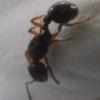Camponotus Vagus is a species of large, black, West Palaeartic carpenter ant with a wide range that includes much of Europe, a large area of Asia, and part of Africa. They are relatively distinctive species that is easily identified by its large size, uniform black colour, and the long and dense body "hairs" on its exoskeleton. A eusocial insect, individuals have continuous allometric variation in size and morphology to facilitate task allocation and partitioning of work. Workers are 6–12 mm in length. The larger "major workers" act as guards for in defence of the colony and protect the smaller "minor workers" when the latter go foraging outside the nests. The powerful mandibles of the major workers are capable of decapitating smaller arthropods captured as food and dismembering smaller ants of other species.
Habitat: The colonies are commonly found in dry habitats, especially open forests and forest edges. C. vagus most typically builds its nests in dead wood, but colonies can also be founder under stones. An average colony has 1,000 to 4,000 workers, but larger colonies contain up to 10,000 individuals.
Diet: C. vagus is known to be both carnivorous and aphidicolous (living in a mutualistic relationship with aphids and feeding upon the honeydew these smaller insects release from the terminations of their alimentary canals).
Day 1
So around the 1st of May, during the May-day celebrations there was a storm coming. C. Vagus is known to fly during dusk before the storm, so while sitting at out summer house, i felt something rather unpleasantly big on my neck. Still, not wanting to kill whatever it was, i slowly picked it up in my hand, and when checked to see what it is, viola! A camponotus queen. After that, i had her moved into a test tube setup.
Day 3
After 3 days i decided to check up on the queen. By now she stopped tugging the cotton and laid a single egg.
Day 14
Its been 14 days so far, and i decided to check up on queen again. She laid 9 eggs so far. Eggs are quite big compared to other species, but then again, the queen herself is 16mm.
Edited by GeorgeK, June 2 2019 - 6:47 AM.





































